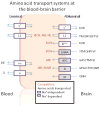Non-physiological amino acid (NPAA) therapy targeting brain phenylalanine reduction: pilot studies in PAHENU2 mice
- PMID: 22976763
- PMCID: PMC3654543
- DOI: 10.1007/s10545-012-9524-8
Non-physiological amino acid (NPAA) therapy targeting brain phenylalanine reduction: pilot studies in PAHENU2 mice
Abstract
Transport of large neutral amino acids (LNAA) across the blood brain barrier (BBB) is facilitated by the L-type amino acid transporter, LAT1. Peripheral accumulation of one LNAA (e.g., phenylalanine (phe) in PKU) is predicted to increase uptake of the offending amino acid to the detriment of others, resulting in disruption of brain amino acid homeostasis. We hypothesized that selected non-physiological amino acids (NPAAs) such as DL-norleucine (NL), 2-aminonorbornane (NB; 2-aminobicyclo-(2,1,1)-heptane-2-carboxylic acid), 2-aminoisobutyrate (AIB), and N-methyl-aminoisobutyrate (MAIB), acting as competitive inhibitors of various brain amino acid transporters, could reduce brain phe in Pah (enu2) mice, a relevant murine model of PKU. Oral feeding of 5 % NL, 5 % AIB, 0.5 % NB and 3 % MAIB reduced brain phe by 56 % (p < 0.01), -1 % (p = NS), 27 % (p < 0.05) and 14 % (p < 0.01), respectively, compared to untreated subjects. Significant effects on other LNAAs (tyrosine, methionine, branched chain amino acids) were also observed, however, with MAIB displaying the mildest effects. Of interest, MAIB represents an inhibitor of the system A (alanine) transporter that primarily traffics small amino acids and not LNAAs. Our studies represent the first in vivo use of these NPAAs in Pah (enu2) mice, and provide proof-of-principle for their further preclinical development, with the long-term objective of identifying NPAA combinations and concentrations that selectively restrict brain phe transport while minimally impacting other LNAAs and downstream intermediates.
Figures








Similar articles
-
Characterization of 2-(methylamino)alkanoic acid capacity to restrict blood-brain phenylalanine transport in Pah enu2 mice: preliminary findings.Mol Genet Metab. 2013;110 Suppl(0):S71-8. doi: 10.1016/j.ymgme.2013.08.004. Epub 2013 Aug 15. Mol Genet Metab. 2013. PMID: 23999161 Free PMC article.
-
Physiological Competition of Brain Phenylalanine Accretion: Initial Pharmacokinetic Analyses of Aminoisobutyric and Methylaminoisobutyric Acids in Pahenu2-/- Mice.Mol Genet Metab Rep. 2015 Jun 1;3:80-87. doi: 10.1016/j.ymgmr.2015.03.009. Mol Genet Metab Rep. 2015. PMID: 26120559 Free PMC article.
-
Therapeutic brain modulation with targeted large neutral amino acid supplements in the Pah-enu2 phenylketonuria mouse model.Am J Clin Nutr. 2016 Nov;104(5):1292-1300. doi: 10.3945/ajcn.116.135996. Epub 2016 Sep 21. Am J Clin Nutr. 2016. PMID: 27655443
-
Optimising amino acid absorption: essential to improve nitrogen balance and metabolic control in phenylketonuria.Nutr Res Rev. 2019 Jun;32(1):70-78. doi: 10.1017/S0954422418000173. Epub 2018 Oct 4. Nutr Res Rev. 2019. PMID: 30284526 Free PMC article. Review.
-
In vivo proton magnetic resonance spectroscopy in phenylketonuria.Eur J Pediatr. 2000 Oct;159 Suppl 2:S121-5. doi: 10.1007/pl00014374. Eur J Pediatr. 2000. PMID: 11043158 Review.
Cited by
-
Excess cerebral TNF causing glutamate excitotoxicity rationalizes treatment of neurodegenerative diseases and neurogenic pain by anti-TNF agents.J Neuroinflammation. 2016 Sep 5;13(1):236. doi: 10.1186/s12974-016-0708-2. J Neuroinflammation. 2016. PMID: 27596607 Free PMC article. Review.
-
Genetic etiology and clinical challenges of phenylketonuria.Hum Genomics. 2022 Jul 19;16(1):22. doi: 10.1186/s40246-022-00398-9. Hum Genomics. 2022. PMID: 35854334 Free PMC article. Review.
-
Pharmacologic inhibition of L-tyrosine degradation ameliorates cerebral dopamine deficiency in murine phenylketonuria (PKU).J Inherit Metab Dis. 2014 Sep;37(5):735-43. doi: 10.1007/s10545-013-9675-2. Epub 2014 Feb 3. J Inherit Metab Dis. 2014. PMID: 24487571 Free PMC article.
-
Single amino acid supplementation in aminoacidopathies: a systematic review.Orphanet J Rare Dis. 2014 Jan 13;9:7. doi: 10.1186/1750-1172-9-7. Orphanet J Rare Dis. 2014. PMID: 24422943 Free PMC article.
-
Characterization of 2-(methylamino)alkanoic acid capacity to restrict blood-brain phenylalanine transport in Pah enu2 mice: preliminary findings.Mol Genet Metab. 2013;110 Suppl(0):S71-8. doi: 10.1016/j.ymgme.2013.08.004. Epub 2013 Aug 15. Mol Genet Metab. 2013. PMID: 23999161 Free PMC article.
References
-
- Arning E, Bottiglieri T, Sun Q, et al. Metabolic profiling in phenylalanine hydroxylase-deficient (Pah−/−) mouse brain reveals decreased amino acid neurotransmitters and preferential alterations of the serotoninergic system. Molec Genet Metab. 2009;98:21.
-
- Babu E, Kanai Y, Chairoungdua A, et al. Identification of a novel system L amino acid transporter structurally distinct from heterodimeric amino acid transporters. J Biol Chem. 2003;278:43838–45. - PubMed
-
- Bodoy S, Martín L, Zorzano A, Palacín M, Estévez R, Bertran J. Identification of LAT4, a novel amino acid transporter with system L activity. J Biol Chem. 2005;280:12002–11. - PubMed
-
- Bröer S, Brookes N. Transfer of glutamine between astrocytes and neurons. J Neurochem. 2001;77:705–19. - PubMed
Publication types
MeSH terms
Substances
Grants and funding
LinkOut - more resources
Full Text Sources
Medical
Research Materials
Miscellaneous

